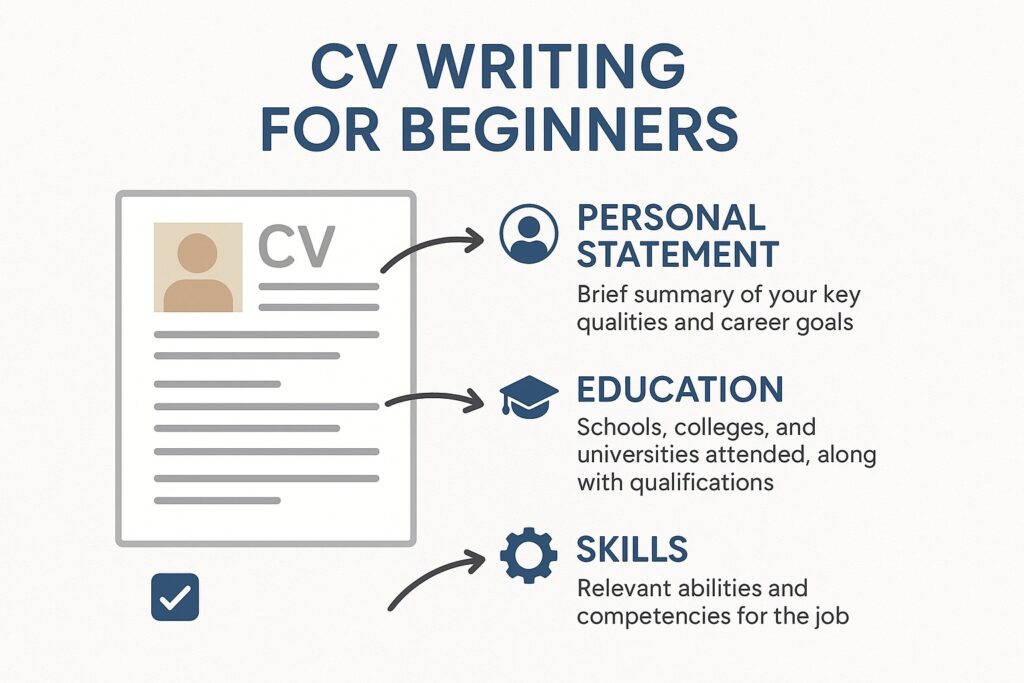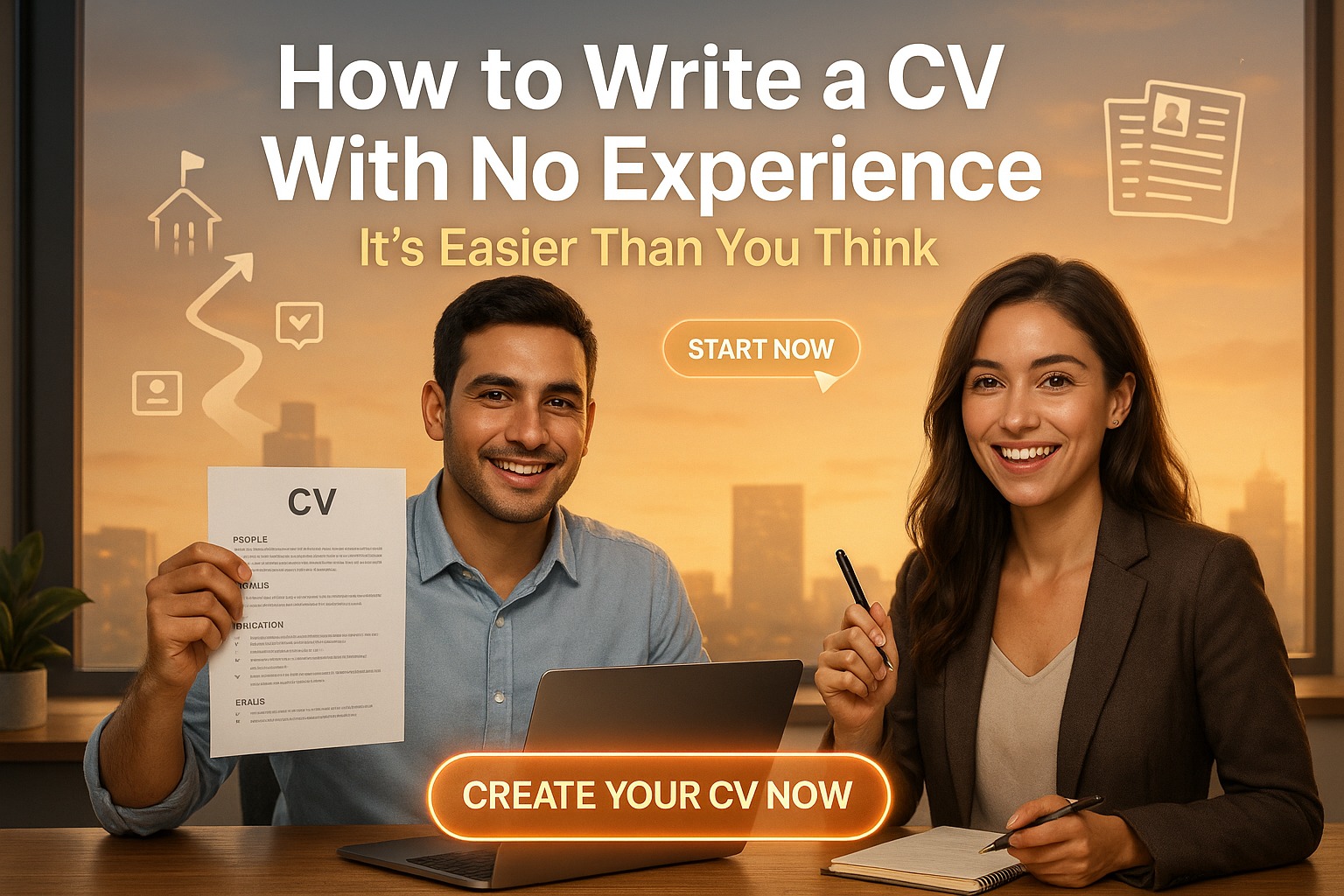Table of Contents
INTRODUCTION
How to Write a CV with no experience is one of the most common yet daunting challenges faced by job seekers, especially fresh graduates or career switchers. But here’s the truth — you don’t need years of job experience to create a strong and compelling CV. What you need is the right structure, strategy, and storytelling.
In this comprehensive guide, you’ll learn how to craft a CV from scratch that showcases your strengths, education, soft skills, and ambitions — even if your work history is empty. This tutorial breaks down the exact steps you need to follow, from formatting and content to customization tips that get noticed by employers.
Whether you’re applying for internships, entry-level jobs, or volunteering roles, this guide will help you:
- Understand what recruiters look for in a no-experience CV
- Learn how to format and structure your CV to maximize impact
- Discover powerful ways to highlight your potential
Difficulty: Beginner
Estimated Time to Complete: 1–2 hours
Outcome: A polished, professional CV that increases your chances of getting interviews

PREREQUISITES / REQUIREMENTS
Before we begin, here’s what you’ll need For How to Write a CV for Beginers
- Basic Computer Skills: Using Word or Google Docs
- Access to a CV Template: Free or paid (we’ll link below)
- List of Personal Experiences: School projects, volunteering, extracurriculars
- Estimated Time: Around 1 hour
- Budget: Free to low-cost (if using premium templates)
This guide is beginner-friendly, so no prior CV writing experience is needed. You can also use free CV builders online if formatting manually feels too complex.
STEP-BY-STEP PROCESS For How to Write a CV
Step 1: Choose the Right CV Format
The best CV format for someone with no experience is the functional or skills-based format. It emphasizes your strengths and potential, not your job history.
- Pro Tip: Avoid chronological formats unless you have some relevant internships or part-time jobs.
- Mistake to Avoid: Don’t leave your CV blank just because you have no jobs. Focus on what you do have.
Step 2: Write a Strong Personal Statement
Start with a personal summary (3–4 lines) that tells the employer who you are, what you’re looking for, and why you’re a great candidate.
Example:
“Motivated recent high school graduate with excellent communication and problem-solving skills, seeking an entry-level customer service position. Passionate about helping people and learning new tools.”
- Tip: Use action words like “motivated,” “eager,” “enthusiastic,” etc.
Step 3: Highlight Your Education
Your education is your main asset. List your most recent school experience, grades, certifications, and relevant coursework or subjects.
Example:
The Peace Group of Colleges, Abbottabad
Intermediate (Pre-Medical), 2021 — 737/1100
- Pro Tip: Mention specific achievements or school projects related to the job.

Step 4: Add Key Skills and Strengths
Even without work experience, you have transferable skills. Think communication, leadership, teamwork, time management.
List 5-8 skills in bullet form. Be honest and relevant.
Example:
- Effective communication
- Team collaboration
- Time management
- Microsoft Office proficiency
- Mistake to Avoid: Listing skills you can’t demonstrate in real life.
Step 5: Include Volunteering, Projects, or Extracurricular Activities
This section replaces the work experience for now. How to Write a CV for Beginers
Examples:
- School science fair organizer
- Volunteer at community clean-up
- Member of college debating society
- Pro Tip: Use the STAR method (Situation, Task, Action, Result) to describe each.
Step 6: Add Certifications or Online Courses
If you’ve completed any free online courses, this is where they go.
Recommended Platforms:
- Coursera (free certificates)
- HubSpot Academy
- LinkedIn Learning
Example:
Introduction to Excel — Coursera, 2024
Customer Service Fundamentals — LinkedIn Learning, 2025
Step 7: List References or Add “Available on Request”
If you don’t have past employers, use teachers, community leaders, or mentors.
- Option 1: List 1-2 references with their name and contact.
- Option 2: Write “References available upon request.”
- Mistake to Avoid: Never fake references.
ADVANCED TIPS & BEST PRACTICES
- Customize Each CV: Tailor your CV for every job using keywords from the job description.
- Keep it One Page: With no experience, one page is ideal.
- Use Professional Fonts: Arial, Calibri, or Times New Roman.
- Avoid Overdesigning: Stick to a clean layout.
- Proofread Thoroughly: Typos = instant rejection.
- Use Action Verbs: Words like “developed,” “organized,” “created” leave strong impressions.
- Save as PDF: It ensures formatting stays intact.
TOOLS & RESOURCES
Here are tools to help you write your CV effortlessly:
Free CV Builders:
- Canva – Great templates with drag & drop (free version)
- Zety – Guided CV builder with suggestions
- NovoResume – Beginner-friendly and modern layouts
Online Learning:
- Coursera – Intro to job skills
- HubSpot Academy – Free certifications
- LinkedIn Learning – Soft skills for job market
Templates:
- Google Docs Resume Templates (Free)
- Microsoft Word Templates
MEASURING SUCCESS & OPTIMIZATION
Track your results by:
- Counting how many interview calls you receive
- Asking for CV feedback from recruiters or mentors
- Using tools like Jobscan to match your CV to job descriptions
- Tracking how often your CV gets viewed on job boards
Revise your CV every 2–3 applications based on response.
NEXT STEPS & ADVANCED TECHNIQUES
- Start building your LinkedIn profile
- Learn how to write effective cover letters
- Practice mock interviews
- Join job seeker communities
- Stay updated on in-demand skills through Coursera or Udemy
CONCLUSION
You don’t need job experience to start your career. What you need is a clear, confident, and well-structured CV that tells your story effectively. By following the steps in this guide, you’ll present yourself as job-ready, enthusiastic, and willing to grow.
Now, it’s time to put your learning into action. Open a new doc, follow these steps, and create your first CV—because getting your first job starts with writing that first CV.
How do I write a CV if I have never worked before?
Start with a skills-based format. Focus on education, transferable skills, volunteer work, and certifications.
Do I need a cover letter with my CV if I have no experience?
Yes, a well-written cover letter helps you explain your passion and strengths. Customize it for each application.
How long should a beginner CV be?
One page is ideal for entry-level or no-experience CVs. Focus on relevance and clarity.
Can I include school projects in my CV?
Absolutely. Highlight projects that demonstrate problem-solving, teamwork, or leadership.
What if I have no skills to list?
You do! Think soft skills like communication, time management, and teamwork. Reflect on your school activities.
INTERNAL LINKS
- Build your LinkedIn with our [LinkedIn Profile Guide]
- boost your chances with our Career Planning Guide
EXTERNAL LINKS
- As recommended by Canva Resume Builder
- According to Coursera Free Courses
- Official templates at Google Docs Resume Templates
You don’t need job experience to get started—you need the right CV





